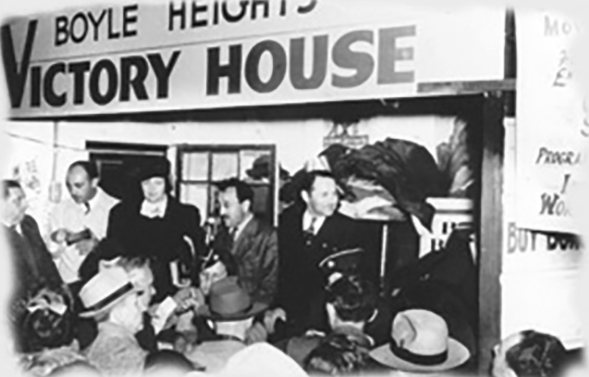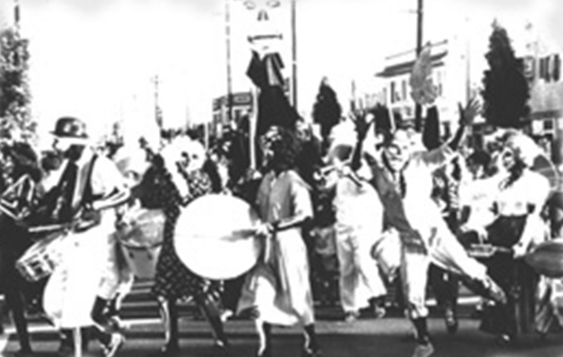
Documenting Community Life
The Boyle Heights Project represents an expansion of the Japanese American National Museum’s partnership initiatives and manifests our commitment to exploring the multicultural experiences of the United States.
This section highlights some of the strategies and methods used to engage in community-based documentation and interpretation.
- Establishing a Community Advisory Committee
- Building Relationships with Community Organizations and Individuals
- Conducting Oral History Interviews to Learn about Community Life
- Conducting Photo Collection Day to Learn about Community Life through Personal Archives
- Organizing Community Forums
- Initiating Partnership Activities
Establishing a Community Advisory Committee
One of the first things we did was establish an active Community Advisory Committee. Using the institutional partners and scholarly advisors as a resource, we identified community leaders who formed a core “working group” for the project.

The Community Advisory Committee formed the backbone of the project. The Committee included educators as well as past and current Boyle Heights residents. They formed several subcommittees that focused on outreach, planning, and implementation of project activities.
Building Relationships
A central activity of the project involves building personal relationships with individuals and organizations related to the neighborhood. The time spent developing this project (nearly three years) was crucial to its success. Relationships are not formed overnight; people are not immediately motivated to participate after a single phone call or after reading a single announcement about the project.
We engaged a number of strategies for disseminating information about the project. We have had media coverage; we distributed flyers through our partners as well as through other organizations; and we contacted people who have been referred to us by others through mail and phone. What we have learned through our outreach activities is that the key to a successful community collaboration is interpersonal relationships and social networks. Tapping into social networks of people connected through formal and informal relationships, such as family ties, friendship, participation, or membership in neighbor organizations, alumni associations, religious institutions, and social clubs has been a powerful tool. Interest has been generated organically over time as people participate in a program and tell a friend about the project.
Conducting Oral Histories to Learn about Community Life
One method of learning about community life through the perspective of those who lived it is through oral histories. Oral histories are a valuable tool for bringing people together to learn about one another. The very endeavor—recording first-person perspectives for use in research—communicates that culture and history can be determined and defined by extraordinary, ordinary people. The experiences of our friends, our families, and our neighbors are important and have historic value. Anyone from a university scholar to a high school student can participate in giving voice to these experiences.

For the project, we conducted oral history training workshops for three different teams of interviewers: a team of research associates convened by the museum, a team of Roosevelt High School students, and graduate students in history from the University of Southern California. In turn, these three teams conducted over 50 oral histories.
The involvement of interviewers of different skill levels yielded a range of results. For example, the high school students required more encouragement and assistance than the university students; interviews are of varied length and depth depending upon who conducted them; some narrators were more talkative or better storytellers than others.
The process of recording oral histories was valuable for all participants—interviewers and narrators alike. The interview process provided meaningful opportunities for people of different generations to meet one another and directly explore the similarities and differences among their respective experiences in the neighborhood. For many of the high school students, this was the first time they had been faced with taking the lead on and directing a discussion with an adult.
The narrators, in turn, expressed that the experience of being interviewed made them think more deeply about their family and community histories. Many were moved that a younger generation of people are interested in learning about the experiences of an older generation. Both the student interviewers and the narrators also expressed that they had previously never considered their neighborhood, community, or experiences to be significant or part of a larger history.
Conducting Photo Collection Day to Learn about Community Life through Personal Archives
Photo “Collection Days” can be a powerful way of identifying photographs and stories that might otherwise go unnoticed. It is also an effective means for directly involving the community and generating excitement. During the weekend of April 29-30, 2000, we held Photo Collection Days at Roosevelt High School. It was also the first activity that launched the Boyle Heights Project to the larger community. The event drew approximately 150 people.
The goal of the Photo Collection Day was to collect duplicate copies of photographic images from personal collections. Owners of the photographs retained ownership of the original photographs. The process included staff and volunteers reviewing photos brought to the Photo Collection Day, selecting photographs for duplication, recording information about each photo, and professionally photographing the image (on site) and returning the original photos to their owners the same day. Images collected are deposited in the archives of the Japanese American National Museum and the Jewish Historical Society of Southern California. 500 photographs from family albums and personal collections that show community life in the neighborhood from the turn of the century to the present were duplicated.
This event worked as an ice breaker. It introduced us to former and current neighborhood residents, many of whom have continued to work with us through the Community Advisory Committee. It also provided a forum for the participants to meet one another, reunite, and share anecdotes and memories. This event proved to be a successful means for collecting images and stories about the neighborhood’s history. New research was generated, leading to additional oral histories, collection activities, and new areas of discovery.
Japanese American National Museum staff trained volunteers assisting with the Photo Collection Day and developed and utilized a workbook as part of the training.
Community Forum
On September 17, 2000, we held a Community Forum at the International Institute of Los Angeles with an attendance of 120 people. All of the partner organizations participated in a presentation that informed the audience of project plans and objectives. Participants were grouped and encouraged by project team leaders to share their different experiences in the neighborhood and suggest themes for us to address in the exhibition and public programs schedule.
The Community Forum format is basic, involving no more than a portable PA system. The real work lies in the coordination of a lot of different people: partners, presenters, discussion leaders, and other event volunteers. The Community Forum enabled us to reinforce personal and community relationships because it required that we all worked together: partners, volunteers, and the community.
The success of this event demonstrated to us that people were eager and willing to participate in a project that explored the history of the neighborhood. One of our advisors remarked afterwards, “I got the sense that all of those people are just waiting for you to tell them what they should do now.”
Organizing Partnership Activities
The Japanese American National Museum is committed to sustaining and expanding meaningful relationships with existing partners beyond the project’s conclusion to promote lasting intercultural relations and linkages between our organizations and communities.
Throughout the project, the partners convened as a group multiple times to discuss partnership development, exhibition content, and public programs. In addition, we organized site visits to each partner organization to strengthen relations and understandings between our staff and volunteers. Additional one-on-one meetings between the project core staff and each project partner were held throughout the course of the project. Every meeting agenda was replicated with each partner, resulting in four-times as many meetings. This, however, proved to be essential to maintaining communication. Utilizing e-mail was also very important to planning and to maintaining consistent and time-critical correspondence.
Examples of Boyle Heights Project partner activities:
-
Jewish Historical Society of Southern California—The Japanese American National Museum supports the Jewish Historical Society in its efforts to restore and develop an old orthodox synagogue in Boyle Heights, known as the Breed Street Shul, into a cultural center that highlights the Los Angeles Jewish experience but also considers and addresses the contemporary neighborhood life. The Jewish Historical Society is also expanding their tour offerings of Boyle Heights to include a multicultural tour of the neighborhood.
-
Self Help Graphics & Art—Self Help Graphics & Art is actively involved as an institutional partner with the Finding Family Stories collaboration of the Japanese American National Museum. This arts collaborative partnership brings together four Los Angeles-based organizations: the Japanese American National Museum, California African American Museum, Chinese American Museum, and Self Help Graphics & Art to create an arts exhibition, About, By, From: Boyle Heights-Expressions, Impressions and Memories of a historic neighborhood in East Los Angeles and programs can be found at a related link: selfhelpgraphics.com
-
Roosevelt High School (RHS)—The Boyle Heights Project is part of an ongoing relationship between the Japanese American National Museum and RHS. Students and teachers have been working with the National Museum for over four years on youth media projects that have been incorporated into exhibitions and a student docent internship program. We will continue to develop collaborative projects with the school in the future. Several students who participated in the Boyle Heights student research project during the 2000-2001 school year with the National Museum have been approached to participate in a new program which trains youth to develop and conduct neighborhood-walking tours. We have met with board members of the Roosevelt High School Alumni Foundation and continue to be invited to participate at RHS reunions.
-
International Institute of Los Angeles (IILA)—We are currently exploring opportunities to expand and deepen our relationship to Boyle Heights residents through our work with the International Institute. This particular partnership affords an excellent opportunity to reach out to newer communities. We look forward to working with the Institute to develop ongoing programs that position the National Museum as an educational resource for their constituents (for example, the National Museum is a site where new immigrants can learn about American history and about the experiences of an earlier generation of immigrants). IILA also contacted Museum staff and requested technical assistance with a photo display for the rededication of their historic neighborhood.
Photos: Abraham Maymudes, chairman of the Jewish Fraternal Order of the International Workers Order, addresses supporters at a bonds sale at the Boyle Heights Victory House, Brooklyn and Soto, 1942. Shades of L.A. Archives/Los Angeles Public Library, August Maymudes (NRC.2002.46.15); Dia de los muertos procession, St. Louis Street, 1977. Photograph by Guillermo Bejarano. Courtesy of Guillermo Bejarano (NRC.2002.61.1)
